 Destroyers built 1918-22, Momi, Kaya, Nashi, Take, Kaki, Tsuga, Nire, Kuri, Kiku, Aoi, Hagi, Fuji, Susuki, Hishi, Hasu, Warabi, Tade, Sumire, Tsuta, Ashi, Yomogi
Destroyers built 1918-22, Momi, Kaya, Nashi, Take, Kaki, Tsuga, Nire, Kuri, Kiku, Aoi, Hagi, Fuji, Susuki, Hishi, Hasu, Warabi, Tade, Sumire, Tsuta, Ashi, YomogiWith the Momi class we cover a new important chapter of the Imperial Japanese Navy, the destroyers. After Battleships, cruisers and aircraft carriers it was important to cover not only their escorts, but ships that also often operate on their own, and carried troops as well, notably during the “tokyo express” runs. Japanese destroyers were quite special and difficult to compare to those of the West, above else what made them special were the Type 96 “special types” torpedoes, giving them a reach and a night combat ability that was unmatched at the time.
In this lineage, we don’t start with the 1916 Momo class, as only one saw service in WW2 (Kashi) but the next Momi class, later considered 2nd class destroyers alongside the Wakatake class, compared to the 1st class Minekaze/Kamikaze and Mutsuki class. The Momi were cut down from 28 planned down to 21. In 1937 they were seen already as obsolete and were converted either as patrol boats, tenders or troop transports in WW2, seeing ample action and many losses.
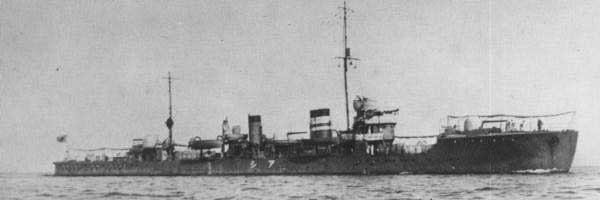
Development
The Momi class destroyers were originally 28 as planned in the Taishō 6 (大正6年) (1917) year naval plan. This F-37 design of 21 ships parallelled the larger Minekaze (F 41), introducing the German-style forecastle with a TT in a well forward of the bridge. They were also the first second class destroyers armed with 21-inches TT. For comparison, Uraga units were to have been powered by Rateau, and Ishikawajima with Zoelly turbines, but except for Sumire and Yomogi with Zoelly (which in Sumire gave much trouble), the Uraga and Ishikawajima ships had Parsons. Nire made 34.35kts on 23,165 shp at 893t in March 1920. They were considered good for 31 kts in service. Kiku group was Design F-37A, with a larger and longer bridge, searchlight abaft second funnel instead of atop the bridge, and foremast separated from bridge. Tsuta group was classed as Design F-37B.
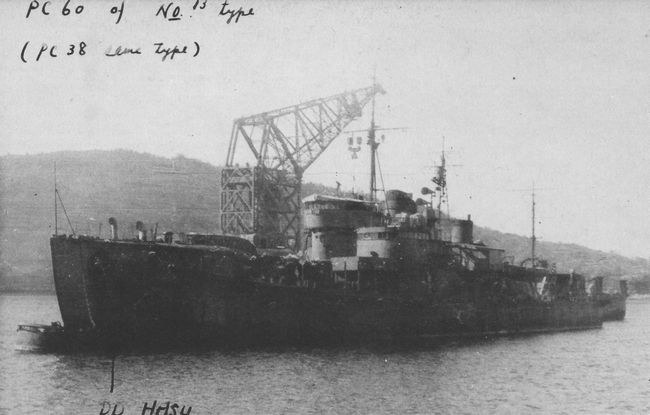
IJN Hasu and the sub-chaser CH-60 in 1947
Design of the class
The Momi-class destroyers were a class of 21 destroyers built for the Imperial Japanese Navy (IJN) during the early 1920s. These ships marked a significant shift in Japanese naval design during the interwar period, focusing on higher speeds and improved seakeeping abilities. Though initially built for fleet actions, by the outbreak of World War II, many were repurposed for other duties due to their relatively outdated capabilities.
They were Built between 1919 and 1923, developed as part of Japan’s ambitious post-World War I naval expansion. Their design followed the successful experiences with earlier destroyers but incorporated lessons from the war with a standard displacement of About 850 tons, full load Around 1,100 tons. This changed over time and especially in WW2. They were relatively small at 85.3 meters (280 feet) and 7.9 meters (26 feet) wide for a reduced draft of 2.5 meters (8.2 feet). They gave them an excellent 1/11 ratio whereas the low draft was an advantage to operate on rovers such as the Yang Tse, but a liability in high seas and heavy weather due to stability.
Hull and general design
The Momi class were comparable to late WWI Italian destroyers and German ones in shape at 864 t (850 long tons) normal and 1,036 t or 1,020 long tons deeply loaded. They measured 83.8 m (275 ft) between perpendicular and 85.3 m (280 ft) overall for a limited beam of 7.9 m (26 ft) and sraft of 2.4 m (8 ft), all for 21,500 shp (16,000 kW) so they were fast. The general design was both repeating the peculiar “German design” featuring a torpedo tube bank forward of the bridge in a “well” behind the short forward bow on which the gun stands.
This peculiar silhouette was known as “the toothbrush design”. All three single, shielded 12 cm (4.7 in) Type 3 guns were mounted high, the first on the short bow, one amidships on a bandstand between funnels and one aft on the radio quarterdeck house. Torpedo armament was light with just two sets of twin tubes, albeit ported to 53.3 cm (21 inches) as new standard. The raised guns was an evidence due to the low freeboard, to avoid water splash. But the deck-level TTs were probably not usable in all sea states.
The bridge was composed of an enclosed room with portholes used as map room, with “shoulders” as the hull was raised at its level, enclosed wings and then open wings above with the open bridge covered with a tarpaulin. A searchlight platform was located aft of it. The masts and funnels were raked, but very slightly. The taller formast supported a spotting top. They had four boats, two powered ones and two rowboat cutters.
Powerplant
The Momi class were powered by two steam geared turbines, each driving one propeller shaft, and three Kampon water-tube boilers for a total output: 21,500 shaft horsepower, giving the class a top speed of around 36 knots and a range of about 3,000 nautical miles at 14 knots. However already they were sub-classes, and thus, differences in the powerplant:
Momi, Kaya, Nashi, Take, Kuri, Fuji, Kiku, Aoi, Ashi, Tsuta, Warabi, Tade had had two 2 sets of Curtis geared steam turbines and Kampon boilers as seen above.
The Kaki sub-class (+Tsuga, Nire, Hagi, Susuki, Hishi, Hasu) differed by having 2 sets Parsons geared steam turbines and 3 Kampon boilers
Sumire and Yomogi had two sets of Zoelly geared steam turbines and 3 Kampon boilers.
So in short:
Brown-Curtis turbines: Kaya, Warabi and Tade
Parsons impulse turbines: Hishi and Hasu
Escher Wyss & Cie Zoelly turbines: Sumire
Mitsubishi Shipbuilding High-pressure impulse turbine and low-pressure reaction turbine: Kaki
General output future accepted by all sources are 21,500 shp for 36 kts. They carried 240t of oil for a limited range of 3000 nautical miles at 15 knots.
During their late modernization either one or two boilers were removed (see below) and performances were down considerably, either if used as unnamed patrol boats (number “#-Go”) or tenders.
Armament
In brief:
-3 × 12 cm/45 (4.7 inch) type 3 naval guns in single mounts, shielded, one forward, one aft, one amidships on a bandstand.
-Four 533 mm (21 inch) torpedo tubes in two twin mounts, one forward, prow well, one between the two main guns aft.
-Two 7.7mm/80 Type 92 light AA amchine guns src
-20 mines and a mechanical minesweeping gear (info in research)
-Depth charges for anti-submarine warfare, see notes.
12 cm/45 3rd Year Type naval gun
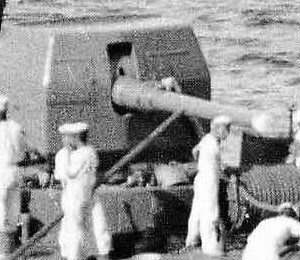 The 12 cm/45 gun was designed in 1895 as an indigenous variant of an Elswick Ordnance Pattern Y under the designation “Type 41”. In 1921 it was declined into an high-angle AA gun, the 12 cm/45 10th Year Type. The base model had a Single motion interrupted screw Welin breech block different from the Type 3 12 cm AA Gun used by the Army in 1943. On destroyers it was always shielded (photo), with the latter fitted with two opening panels. From 1922 the gun evolved into the 12 cm 11th Year Type naval gun (Model 1922) with a shorter gun barrel and horizontal sliding breech-block but reserved for TBs and submarines only. Manually loaded it fired a 20.3 kg (45 lb) high-explosive or illumination shell. The patrol conversions from 1943 also received an anti-submarine shell.
The 12 cm/45 gun was designed in 1895 as an indigenous variant of an Elswick Ordnance Pattern Y under the designation “Type 41”. In 1921 it was declined into an high-angle AA gun, the 12 cm/45 10th Year Type. The base model had a Single motion interrupted screw Welin breech block different from the Type 3 12 cm AA Gun used by the Army in 1943. On destroyers it was always shielded (photo), with the latter fitted with two opening panels. From 1922 the gun evolved into the 12 cm 11th Year Type naval gun (Model 1922) with a shorter gun barrel and horizontal sliding breech-block but reserved for TBs and submarines only. Manually loaded it fired a 20.3 kg (45 lb) high-explosive or illumination shell. The patrol conversions from 1943 also received an anti-submarine shell.
Thuis gun was ubiquitous for early IJN destroyers, also found on the Kamikaze, Kawakaze, Minekaze, Mutsuki, Wakatake class destroyer as well as the Chidori/Erotofu class TBs and the Shimushu and Tsukushi class escort/survey ships of the Hashidate class gunboats.
⚙ specifications 12 cm/45 3rd Year |
|
| Weight | 3,240 kg (7,140 lb) |
| Barrel length | 5.4 m (18 ft) bore |
| Elevation/Traverse | -7° +33° and 120°/120° |
| Loading system | Welin breech block, Hydro-pneumatic recoil |
| Muzzle velocity | 825 m/s (2,710 ft/s) |
| Range | 16 km (10 mi) at 33° |
| Crew | 6 |
| Round | 20.3 kg (45 lb) 120 x 550 mm.R., sep. loading cased charge |
| Rate of Fire | 5–6 rpm |
As for torpedoes, these ships had access to a wide variety of 533 mm models, the 21″ (53.3 cm) Type 43 and Type 44 No. 1/2 1911 models, and were certainly planned with the Type 6 (1917) which entered service in 1918, wit the first ships completed in late 1919.
Type 6 (1917)
Initially planned for battlecruisers and battleships of the “8-8-8” plan, later cancelled with the Washington treaty. Standard 43 cm torpedo for new cruisers and destroyers when metric was used also for these models.
⚙ specifications |
|
| Weight | 3,157 lbs. (1,432 kg) |
| Dimensions | 269 in (6.84 m) |
| Propulsion | Kerosene-air wet-heater |
| Range/speed setting | 7,000 m/35, 10,000m/32, 15,000m/26 knots |
| Warhead | 448 lbs. (203 kg) Shimose |
| Guidance | Straight course |
Depth Charges
Standard Type 95, 30.5″ by 17.7″ (77.5cm by 45cm). 220 lb (100 kg) charge, Type 88 explosive (ammonium perchlorate and ferrosilicate). Fuse using a water inlet. 100 feet (30m) and 200 feet (60m) settings (after the revelations of a US Congressman).
Later increased to 324 lb (147kg), Type 97 explosive (70% TNA/30% HNDA), 300 foot (90m) setting.
-1944 Type 2: 230 lbs (105kg) Type 97 explosive settings 98, 197, 292, 390, 480 feet (30m, 60m, 89m, 120m, and 145m).
-1945 Type 2: 357 lbs (162kg) explosives.
Mines
20 mines on rails, no precision given. Can be any of the models here.
Sensors
93-shiki (Type 93) sonar (1943):2 kW 4400 lbs (2000 kg) model, FRQ 17.5 kHz, receiver gain 120 decibels 2, 4, or 8 seconds pulse interval, range up to 1640-3300-6600 yards (1500m-3000m-6000m) at 3°/10° resolution.
3-shiki (Type 3) 1-go radar: Surviving destroyers in 1944-45. 2 arrays of 5 dipoles, 10 kW, wlg 20, PRF 500, range 150 km effective, 300 km max.

IJN Hasu in the interwar, original configuration

IJN Tsuta in 1943, reconverted as Daihatsu carrier
⚙ specifications |
|
| Displacement | 864 t normal, 1,036 t deep load |
| Dimensions | 85.3 x 7.9 x 2.4m (280 x 26 x 8 ft) |
| Propulsion | 2 shafts Parsons steam turbines, 3 Kampon water-tube boilers 21,500 shp (16,000 kW) |
| Speed | 36 knots (67 km/h; 41 mph) |
| Range | 3,000 nmi (5,600 km; 3,500 mi) at 15 knots (28 km/h; 17 mph) |
| Armament | 3× 12 cm (4.7 in) Type 3 guns, 2×2 53.3 cm (21 in) TTs, see notes |
| Sensors | |
| Crew | 148 |
Modernization and Combat actions in WW2
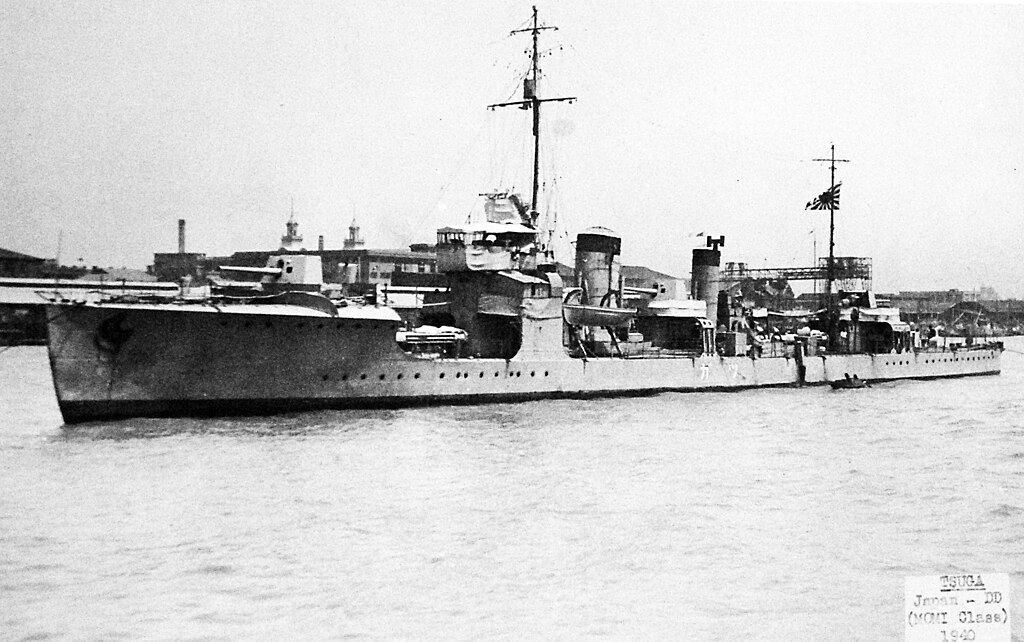
IJN Tsuga as built
The Momi-class destroyers were indeed relatively small but fast, designed to operate alongside the fleet for torpedo attacks and screening duties. Their size made them nimble, but their light armament and limited endurance were seen as weaknesses compared to newer destroyer designs that emerged later. By the late 1930s, many of the Momi-class destroyers were deemed obsolete for frontline combat roles due to advancements in destroyer design and the growing demands of modern naval warfare. Several ships were converted into auxiliary roles, such as patrol boats or fast transports. Modifications included the Removal of some of the original armament (torpedo tubes and naval guns), addition of more anti-aircraft weaponry and depth charges and enhanced cargo or troop-carrying capacity for their new transport roles.
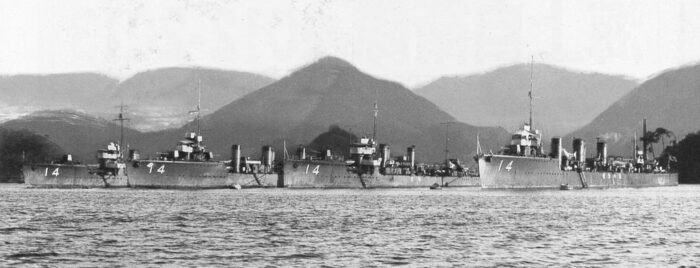
DDs of the 14th Destroyer group in 1926
The Momi-class destroyers served the Imperial Japanese Navy through the 1920s and 1930s, but by World War II, many were used in secondary or auxiliary roles. During the 1920s and 1930s, the Momi-class ships performed various roles, including fleet screening, patrols, and training exercises. At the onset of the Pacific War, some Momi-class destroyers were still operational, but many had been converted into auxiliary patrol vessels or transports. These ships were primarily assigned to coastal defense, convoy escort, and transport missions in less contested areas. Many of the ships were lost during the war due to air attacks, submarine attacks, and general wear and tear from extended service.
Due to their shallow draft, the Momi-class performed well in coastal waters, along the coast of China and notably supporting amphibious landings in the Second Sino-Japanese War.
1939: Aoi, Fuji, Hagi, Hishi, Kiku, Satsuki, Tade, Tsuta and Yomogi converted into patrol vessels.
1940: Ashi, Kaki, Nine, Sumire, and Take disarmed, re-rated as training ships.
Although relatively outdated by World War II, they were versatile and saw action in various auxiliary roles throughout the war. Their adaptability to different functions, such as patrol boats and fast transports, helped Japan extend the operational life of these aging ships. However, the class’s small size and light armament made them less effective in direct naval combat by the time of the conflict. Their construction provided valuable lessons for IJN destroyer design and tactics, influencing the more advanced classes that followed, such as the Fubuki and Asashio classes.
Conversions
In 1937 Fuji, Susuki, Hishi, Hasu, Tsuka, Yomogi and Tade had their funnels raised and capped.
Reconstructions for escort work began in 1939, when Fup, Kiku, Aoi, Susuki, Hishi, Yomogi, and Tade had their after 4.7in guns and their TT (and one boiler) removed, for a battery of 2-4.7in, 6-25mm AA, and 60 DCs.
They then displaced 935t, 12,000shp = 18kts. They were then redesignated in a numbered Patrol Boat series, as noted above. Nire, Take, Kake, Ashi and Sumire were similarly modified in 1940, with one or two 4.7in guns and 2-21-in TT (9000shp = 14kts). They served as tenders. That left only Hasu, Kuni and Tsuga as destroyers. During 1942-43 their amidships 4.7in guns were replaced by 2 triple 25mm AA.
The patrol boats (less Kiku, No 31) were rebuilt as fast transports in 1941, their sterns modified to launch a 46ft Daihatsu landing craft with 150 troops. By 1942 they were armed with 2-4.7in and 6—25mm AA. No 31, the only remaining patrol boat, had 24.7in, 8—25mm, and 60 DCs. Osu and Mitaka were disarmed and fitted with wooden deckhouses for accommodation and training in 1944.
Due to their shallow draft, they were much used in Chinese waters. They were used for amphibious fire support and escort during World War Two.
Nine ships in the Momi class were actually converted to patrol boats in 1939 and displacement rose to 1,162t on trials, with a revised armament of 4.7in/45, six 25mm AA, 60 depht charges, and performance down with one boiler removed at 1,200 shp for 18kts to speed. All except No 37 had sterns modified in 1941 so they were able to carry and launch one 46ft Daihatsu landing craft with 150 troops.
The light AA armament of No 3/7 was increased to 825mm in 1941.
Unconverted vessels, IJN Nire, Take, Kaki, Ashi and Sumtre were disarmed in 1939, re-rated as tenders in 1940.
Displacement: 755t standard, armament two 2-4.7-in/45, two 21in TT and performance down with two boilers removed at 9,000shp for 14kts. Used for training, four were renamed in 1944-45 as follows: Tomariura No 1 (ex-Nire), Osu (ex-Kaki), Tomanura No 2 (ex-Ashi), Mitaka (ex-Sumire). Warabi was lost by collision with the cruiser Fintsu, several were lost during the war, while Kuri hit a mine postwar.
A brief overview of the following Wakatake class: Originally numbered, the names being assigned in 1928. Five further units were cancelled following the Washington Treaty. Yugao was converted to a patrol boat in 1939-40, data becoming: displacement 1130t trials, armament 2-4.71n/45, 8-25mm AA, 60 DCs, and performance with one boiler removed 10,000shp down to 18kts. Wartime armament of the unconverted ships was 2-4.7in/45, six 25mm AA, some 13.2mm AA, four 21-in TT (Asagao two 21-in TT), 36-48 DCs. Sawarabi capsized and sank in heavy weather in 1932, six were war losses (five to US submarines, Wakatake to US carrier aircraft), and Asagao survived, heavily damaged.
Career of the Momi class
 IJN Momi
IJN Momi
IJN Momi (樅) was laid down Yokosuka Naval Arsenal on 23 January 1918, launching on 10 June 1919 and completed on 27 December 1919. Momi turned over during speed trials in 1932. Damage was so extensive she was decommissioned on 1 April 1932, renamed Disposal Destroyer No.2 (Haiku 2-Gō) and used for trials until 1936, BU.
 IJN Kaya
IJN Kaya
IJN Kaya (榧) was laid down at Yokosuka on 23 December 1918, launched on 10 June 1919 and completed on 28 March 1920. She was decommissioned on 1 February 1940 and scrapped.
 Nashi
Nashi
IJN Nashi (梨) was laid dwon at Kawasaki Shipyards in Kobe on 2 February 1918, launched on 26 August 1919 and completed on 10 December 1919.
 Take
Take
IJN Take (竹) was laid down at Kawasaki, Kobe, on 2 December 1918, launched on 26 August 1919 and completed on 25 December 1919. She was decommissioned on 1 February 1940 and converted to training ship, survived WW2 and was scuttled as breakwater at Akita port in 1948.
 Kaki
Kaki
Kaki (柿) was laid down at Uraga Dock Company on 27 February 1919, launched on 20 October 1919 and commissioned on 2 August 1920. She was decommissioned on 1 April 1940 and converted to training ship, then re-converted to the auxiliary ship Ōsu (大須) on 23 February 1945 and scrapped in 1948.
 Tsuga
Tsuga
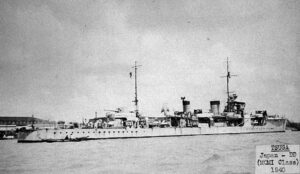 Tsuga (栂) was laid down at Ishikawajima Shipyards on 5 March 1919, launched on 17 April 1920 and completed on 20 June 1920. In December 1941, assigned to the China Area Fleet with Hasu and Huri. Supported the invasion of Hong Kong and started convoy escort and patrols off the Chinese coast. Sunk by carrier aircraft from Task Force 38 in the South China Sea raid off Taiwan on 15 January 1945. Struck on 10 March 1945.
Tsuga (栂) was laid down at Ishikawajima Shipyards on 5 March 1919, launched on 17 April 1920 and completed on 20 June 1920. In December 1941, assigned to the China Area Fleet with Hasu and Huri. Supported the invasion of Hong Kong and started convoy escort and patrols off the Chinese coast. Sunk by carrier aircraft from Task Force 38 in the South China Sea raid off Taiwan on 15 January 1945. Struck on 10 March 1945.
 Nire
Nire
IJN Nire (楡) was laid down at Kure Naval Arsenal on 5 September 1919, launched on 22 December 1919 and completed on 31 March 1920. She was decommissioned on 1 February 1940 and converted to training ship, then re-converted to the auxiliary ship No.1 Tomariura (Dai-1) on 15 December 1944 and scrapped in 1948.
 Kuri
Kuri
IJN Kuri (栗) was laid down at Kure Naval Arsenal on 5 December 1919, launched on 19 March 1920 and completed on 30 April 1920. In the Sino-Japanese War she supported naval landings at Anqing, Battle of Wuhan. At the start of the Pacific War she blockaded Corregidor island and Manila, taking part in the Battle of the Philippines. She spent the rest of the war in patrol duty convoy escort. She was surrendered at Qingdao at the end of the war but afterwards while minesweeping the port approaches she hit a mine off of Pusan on October 8, 1945. Survived, but was declared a total constructive loss, struck 25 October 1945.
 Kiku
Kiku
IJN Kiku (菊) was laid down at Kawasaki Shipyards in Kobe on 20 January 1920, launched on 13 October 1920 and ompleted 10 December 1920. She was Converted to Patrol Boat No.31 (第三十一号哨戒艇, Dai-31-Gō shōkaitei) 1 April 1940; sunk at Palau, 31 March 1944 by air attack from Task Force 58 near Palau, struck 10 May 1944.
 Aoi
Aoi
IJN Aoi (葵) was laid down at Kawasaki, Kobe, on 1 April 1920, launched on 9 November 1920 and completed on 10 December 1920. She was converted to Patrol Boat No.32 (Dai-32-Gō shōkaitei) on 1 April 1940. She was deliverately grounded on 23 December 1941 at Wake Island to allow her SNLF to land, total constructive loss, struck on 15 January 1942.
 Hagi
Hagi
IJN Hagi (萩) was laid down at Uraga on 28 February 1920, launched on 29 October 1920 and completed on 20 April 1921. She was converted to Patrol Boat No.33 (Dai-33-Gō shōkaitei) on 1 April 1940. She was deliberately run aground on 23 December 1941 during the second Battle of Wake Island to allow her Special Naval Landing Force (SNLF) troops to disembark. Nearby Marine anti-aircraft guns then set her on fire. Patrol Boat No. 33 was struck from the Navy List on 15 January 1942.
 Fuji
Fuji
IJN Fuji (藤) was laid down at Fujinagata Shipyards on 6 December 1919, launched on 27 November 1920 and completed on 31 May 1921. She was converted to Patrol Boat No.36 on 1st April 1940. Active in WW2. She surrendered to Netherlands in July 1946 at Surabaya and was BU on 10 August 1946.
 IJN Susuki
IJN Susuki
Susuki (薄) was laid down at Ishikawajima Shipyards on 3 May 1920, launched on 21 February 1921 and completed on 25 May 1921, assigned to Destroyer Division 15. She was Converted to Patrol Boat No.34 (Dai-34-Gō shōkaitei) on 1 April 1940. Sunk 6 March 1943 in collision with Yakaze off Kavieng, written off 10 January 1945.
 IJN Hishi
IJN Hishi
Hishi (菱) was laid down at Uraga Dock on 10 November 1920, launched on 9 May 1921 and completed on 23 March 1922. She was converted to Patrol Boat No.37 on 1 April 1940. Active, sunk off Borneo by USS Pope 24 January 1942, stricken 10 April 1942.
 IJN Hasu
IJN Hasu
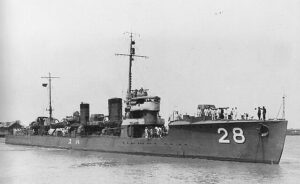 Hasu (蓮) was from Uraga Dock, laid down on 2 March 1921, launched on 8 December 1921 and completed on 31 July 1922. Active in WW2, retired 12 October 1945 and scuttled as breakwater in Fukui, 1946.
Hasu (蓮) was from Uraga Dock, laid down on 2 March 1921, launched on 8 December 1921 and completed on 31 July 1922. Active in WW2, retired 12 October 1945 and scuttled as breakwater in Fukui, 1946.
 IJN Warabi
IJN Warabi
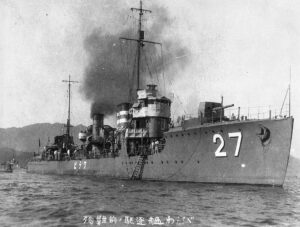 Warabi (蕨) was laid down at Fujinagata Shipyards on 12 October 1920, launched on 28 September 1921 and completed on 19 December 1921. She sunk on 24 August 1927 after a collision with Jintsu (rammed at full speed) off Cape Miho and stricken on 15 September 1927.
Warabi (蕨) was laid down at Fujinagata Shipyards on 12 October 1920, launched on 28 September 1921 and completed on 19 December 1921. She sunk on 24 August 1927 after a collision with Jintsu (rammed at full speed) off Cape Miho and stricken on 15 September 1927.
 IJN Tade
IJN Tade
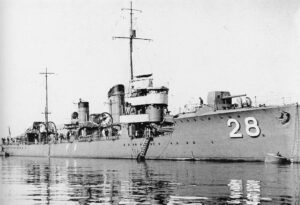 Tade (蓼) was laid down at Fujinagata on 20 December 1920, launched on 15 March 1921 and completed on 31 July 1922. She was converted to Patrol Boat No.39 on 1 April 1940. She was torpedoed off Yonaguni by USS Seawolf (SS-197) on 23 April 1943, stricken 1 July 1943.
Tade (蓼) was laid down at Fujinagata on 20 December 1920, launched on 15 March 1921 and completed on 31 July 1922. She was converted to Patrol Boat No.39 on 1 April 1940. She was torpedoed off Yonaguni by USS Seawolf (SS-197) on 23 April 1943, stricken 1 July 1943.
 IJN Sumire
IJN Sumire
Sumire (菫) was laid down on Ishikawajima Shipyards on 24 November 1920, launched on 14 December 1921 and completed on 31 March 1923. She serviced in her role for 17 years. She was decommissioned on 1 February 1940, disarmed, converted to training ship, re-converted to auxiliary ship Mitaka on 23 February 1945 and scrapped in 1948.
 IJN Tsuta
IJN Tsuta
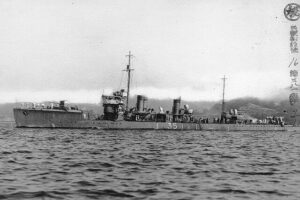 Tsuta (蔦) was laid down at at Kawasaki on 16 October 1920, launched on 9 May 1921 and commissioned on 30 June 1921, assigned to Destroyer Division 15. She was converted to the Patrol Boat No.35 on 1 April 1940. She was sunk at Lae by air attack 2 September 1942, stricken February 1943
Tsuta (蔦) was laid down at at Kawasaki on 16 October 1920, launched on 9 May 1921 and commissioned on 30 June 1921, assigned to Destroyer Division 15. She was converted to the Patrol Boat No.35 on 1 April 1940. She was sunk at Lae by air attack 2 September 1942, stricken February 1943
 IJN Ashi
IJN Ashi

Ashi (葦) was laid down at Kawasaki on 15 November 1920, launched on 3 September 1921 and completed on 29 October 1921. She was decommissioned on 1 February 1940 and converted to a training ship, then re-converted to auxiliary ship No.2 Tomariura on 15 December 1944 and again as a Shin’yō suicide motorboatt mothership in 1945, unused, scrapped 1947.
 IJN Yomogi
IJN Yomogi
 Yomogi (蓬) was laid down at Ishikawajima on 26 February 1921, launched on 14 March 1922 and commissioned on 19 August 1922. She was converted to Patrol Boat No.38 on 1 April 1940. She was torpedoed in the Bashi Strait by USS Atule 25 November 1944 and stricken on 10 March 1945.
Yomogi (蓬) was laid down at Ishikawajima on 26 February 1921, launched on 14 March 1922 and commissioned on 19 August 1922. She was converted to Patrol Boat No.38 on 1 April 1940. She was torpedoed in the Bashi Strait by USS Atule 25 November 1944 and stricken on 10 March 1945.
Read More/Src
Books
Jentsura, Warships of the Imperial Japanese Navy, 1869-1945
Howarth, The Fighting Ships of the Rising Sun
Globalsecurity.org, IJN Momi class destroyers
Stille, Mark (2017). Imperial Japanese Navy Antisubmarine Escorts 1941–45. Oxford, UK: Osprey Publishing.
Destroyers of World War Two: An International Encyclopedia. pp. 188/189
Gardiner, Robert & Gray, Randal, eds. (1985). Conway’s All the World’s Fighting Ships 1906–1921.
Evans, David (1979). Kaigun: Strategy, Tactics, and Technology in the Imperial Japanese Navy, 1887-1941. USNI
Howarth, Stephen (1983). The Fighting Ships of the Rising Sun: The Drama of the Imperial Japanese Navy, 1895–1945. Atheneum
Jentschura, Hansgeorg; Jung, Dieter & Mickel, Peter (1977). Warships of the Imperial Japanese Navy, 1869–1945. NIP
Watts, Anthony J. & Gordon, Brian G. (1971). The Imperial Japanese Navy. Garden City, New York: Doubleday.
Links
combinedfleet.com Momi class
on pwencycl.kgbudge.com/ pacific encyclo
on admiral31.world.coocan.jp
on maritimequest.com/
navypedia.org/
on en.wikipedia.org
ordnanceandmilitaria.com 110-to-149mm-ammo
navweaps.com/ 120mm/45
navweaps.com 120mm/45
List_of_Japanese_World_War_II_radars
navweaps.com/ Pre WWII torpedoes
pwencyc IJN Depth_Charges
momi class on commons.wikimedia.org
smmlonline.com/ minekaze.html
Model Kits
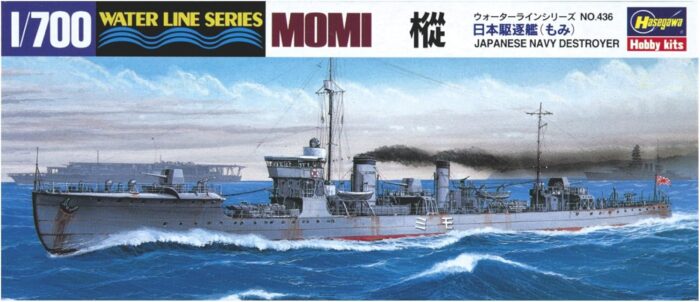
Hasegawa 30058 Japanese Navy Destroyer Momi & Wakatake “Hyper Detail” 1:700
On scalemates
3D
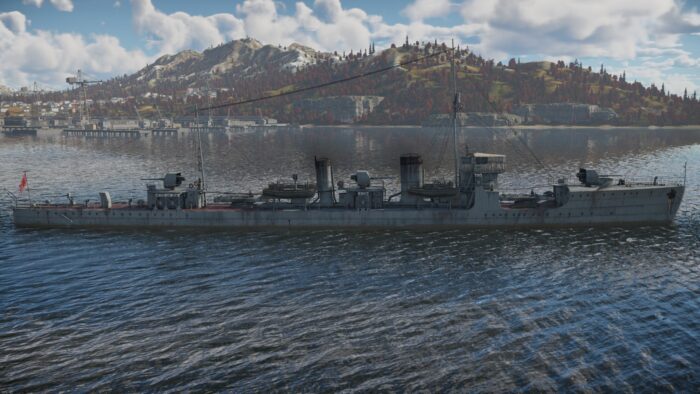
Rendition in warthunder
on deviantart.com
Yūzuki


 Latest Facebook Entry -
Latest Facebook Entry -  X(Tweeter) Naval Encyclopedia's deck archive
X(Tweeter) Naval Encyclopedia's deck archive Instagram (@navalencyc)
Instagram (@navalencyc)





 French Navy
French Navy Royal Navy
Royal Navy Russian Navy
Russian Navy Armada Espanola
Armada Espanola Austrian Navy
Austrian Navy K.u.K. Kriegsmarine
K.u.K. Kriegsmarine Dansk Marine
Dansk Marine Nautiko Hellenon
Nautiko Hellenon Koninklije Marine 1870
Koninklije Marine 1870 Marinha do Brasil
Marinha do Brasil Osmanlı Donanması
Osmanlı Donanması Marina Do Peru
Marina Do Peru Marinha do Portugal
Marinha do Portugal Regia Marina 1870
Regia Marina 1870 Nihhon Kaigun 1870
Nihhon Kaigun 1870 Preußische Marine 1870
Preußische Marine 1870 Russkiy Flot 1870
Russkiy Flot 1870 Svenska marinen
Svenska marinen Søværnet
Søværnet Union Navy
Union Navy Confederate Navy
Confederate Navy Armada de Argentina
Armada de Argentina Imperial Chinese Navy
Imperial Chinese Navy Marinha do Portugal
Marinha do Portugal Mexico
Mexico Kaiserliche Marine
Kaiserliche Marine 1898 US Navy
1898 US Navy Sovietskiy Flot
Sovietskiy Flot Royal Canadian Navy
Royal Canadian Navy Royal Australian Navy
Royal Australian Navy RNZN Fleet
RNZN Fleet Chinese Navy 1937
Chinese Navy 1937 Kriegsmarine
Kriegsmarine Chilean Navy
Chilean Navy Danish Navy
Danish Navy Finnish Navy
Finnish Navy Hellenic Navy
Hellenic Navy Polish Navy
Polish Navy Romanian Navy
Romanian Navy Turkish Navy
Turkish Navy Royal Yugoslav Navy
Royal Yugoslav Navy Royal Thai Navy
Royal Thai Navy Minor Navies
Minor Navies Albania
Albania Austria
Austria Belgium
Belgium Columbia
Columbia Costa Rica
Costa Rica Cuba
Cuba Czechoslovakia
Czechoslovakia Dominican Republic
Dominican Republic Haiti
Haiti Hungary
Hungary Honduras
Honduras Estonia
Estonia Iceland
Iceland Eire
Eire Equador
Equador Iran
Iran Iraq
Iraq Latvia
Latvia Liberia
Liberia Lithuania
Lithuania Mandchukuo
Mandchukuo Morocco
Morocco Nicaragua
Nicaragua Persia
Persia San Salvador
San Salvador Sarawak
Sarawak Uruguay
Uruguay Venezuela
Venezuela Zanzibar
Zanzibar Warsaw Pact Navies
Warsaw Pact Navies Bulgaria
Bulgaria Hungary
Hungary

 Bundesmarine
Bundesmarine Dutch Navy
Dutch Navy Hellenic Navy
Hellenic Navy Marina Militare
Marina Militare Yugoslav Navy
Yugoslav Navy Chinese Navy
Chinese Navy Indian Navy
Indian Navy Indonesian Navy
Indonesian Navy JMSDF
JMSDF North Korean Navy
North Korean Navy Pakistani Navy
Pakistani Navy Philippines Navy
Philippines Navy ROKN
ROKN Rep. of Singapore Navy
Rep. of Singapore Navy Taiwanese Navy
Taiwanese Navy IDF Navy
IDF Navy Saudi Navy
Saudi Navy Royal New Zealand Navy
Royal New Zealand Navy Egyptian Navy
Egyptian Navy South African Navy
South African Navy






























 Ukrainian Navy
Ukrainian Navy dbodesign
dbodesign